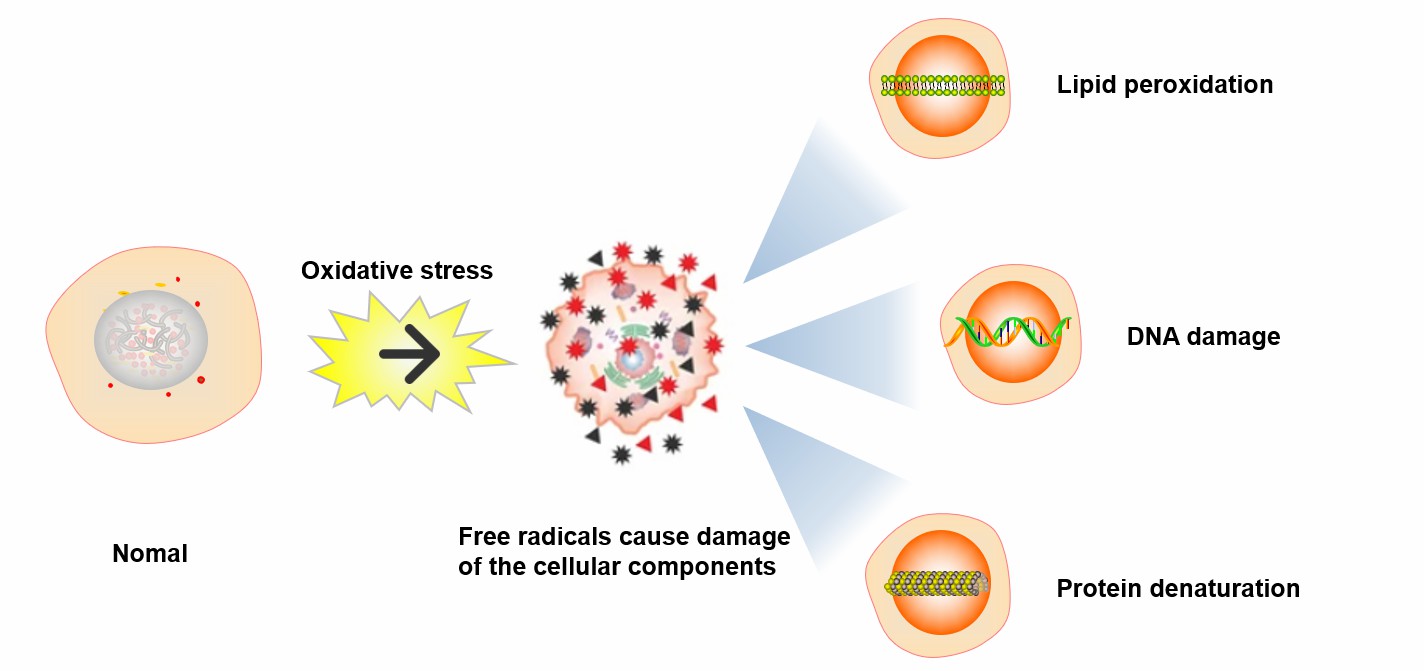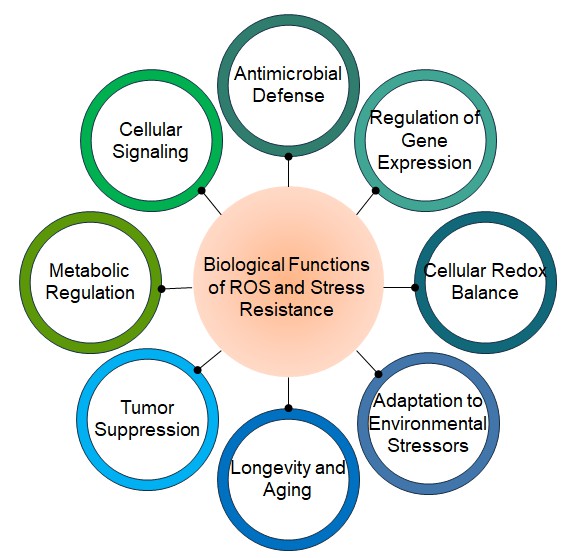ROS and Stress Resistance
About ROS and Stress Resistance
Reactive Oxygen Species (ROS) and stress resistance (or Stress Response) are two interconnected topics that have gained significant attention in the field of biology and medicine.
ROS are highly reactive molecules and include species such as superoxide anion (O2−), hydrogen peroxide (H2O2), and hydroxyl radical (OH·). They are generated as byproducts of normal cellular metabolism, and their levels can increase under various stress conditions such as exposure to toxins, radiation, or extreme temperatures. ROS can cause damage to cells and biomolecules, including DNA, proteins, and lipids, leading to oxidative stress. However, research has also shown that ROS can act as signaling molecules and play a role in cellular defense mechanisms against stress. Organisms have evolved sophisticated antioxidant systems to regulate ROS levels and prevent excessive oxidative damage. These systems include enzymes such as superoxide dismutase (SOD), catalase, and glutathione peroxidase, as well as non-enzymatic antioxidants like vitamin C, vitamin E, and glutathione. These antioxidants neutralize ROS or repair oxidative damage.
Stress resistance refers to an organism's ability to cope with various stressors, maintain homeostasis, and minimize the damage caused by stress. The balance between ROS generation and antioxidant defense systems is crucial for stress resistance.
Studies have suggested that moderate levels of ROS can induce a protective response known as hormesis, which enhances stress resistance and promotes longevity. This hormetic response involves the activation of various stress response pathways, including the antioxidant response element (ARE), heat shock response (HSR), and unfolded protein response (UPR). These pathways regulate the expression of genes involved in antioxidant defense, protein quality control, and stress resilience.
Understanding the interplay between ROS and stress resistance can have significant implications for various fields, including aging, neurodegenerative diseases, and cancer.

Mechanisms of Action or Signaling of ROS and Stress Resistance
- Activation of Stress Response Pathways: ROS can activate stress response pathways in cells. One of the key pathways is the nuclear factor-erythroid 2-related factor 2 (Nrf2) pathway. Under normal conditions, Nrf2 is sequestered in the cytoplasm by Kelch-like ECH-associated protein 1 (Keap1). However, when cells are exposed to oxidative stress or electrophilic compounds, ROS can modify Keap1 and impair its ability to bind to Nrf2. This leads to the stabilization and translocation of Nrf2 into the nucleus, where it binds to antioxidant response elements (AREs) in the promoter regions of target genes. Activation of Nrf2 results in the upregulation of various antioxidant enzymes, such as superoxide dismutase (SOD), catalase, and glutathione peroxidase, as well as phase II detoxification enzymes, to counteract oxidative stress and maintain cellular redox balance.
- Modulation of Signaling Pathways: ROS can modulate the activity of various signaling pathways involved in cellular processes, such as growth, survival, and inflammation. For example, ROS can activate mitogen-activated protein kinases (MAPKs), including extracellular signal-regulated kinases (ERKs), c-Jun N-terminal kinases (JNKs), and p38 MAPK. Activation of MAPKs by ROS can lead to the phosphorylation and activation of downstream transcription factors and modulate gene expression related to cell proliferation, differentiation, and apoptosis. Additionally, ROS can influence the activity of transcription factors, such as nuclear factor-kappa B (NF-κB) and activator protein 1 (AP-1), which regulate the expression of genes involved in immune responses and inflammation.
- Oxidative Modification of Biomolecules: ROS can directly oxidize and modify biomolecules, including proteins, lipids, and nucleic acids. These modifications can have both positive and negative effects on cellular signaling and stress response. For example, ROS-mediated oxidation of cysteine residues in proteins can lead to conformational changes and activation of specific signaling pathways. On the other hand, excessive ROS can cause oxidative damage to proteins, disrupting their structure and function. Lipid peroxidation, initiated by ROS, can generate reactive lipid species that can further modulate cellular signaling pathways. Oxidative DNA damage caused by ROS can lead to genetic mutations and genomic instability.
- Crosstalk with Cellular Metabolism: ROS and stress resistance pathways are interconnected with cellular metabolism. ROS can be generated as byproducts of metabolic processes, such as mitochondrial respiration. In turn, ROS can impact metabolic pathways by modifying the activity of enzymes involved in glucose metabolism, lipid metabolism, and energy production. For example, ROS can influence insulin signaling and the activity of key metabolic enzymes, such as glycogen synthase kinase 3 (GSK3) and AMP-activated protein kinase (AMPK). Furthermore, stress resistance pathways, such as Nrf2 activation, can regulate metabolic processes by modulating the expression of genes involved in glucose uptake, lipid metabolism, and mitochondrial function.
- Modulation of Epigenetic Regulation: ROS can influence epigenetic modifications, which play a crucial role in gene expression regulation. ROS-mediated oxidative stress can lead to DNA damage and affect DNA methylation patterns and histone modifications. These epigenetic changes can influence gene expression profiles and cellular responses to stress. ROS can also modulate the activity of enzymes involved in DNA repair and chromatin remodeling, further impacting gene expression regulation.
These mechanisms collectively contribute to cellular adaptation and resilience to oxidative stress and various stressors, ensuring cellular homeostasis and survival.
Biological Functions of ROS and Stress Resistance

- Cellular Signaling: ROS serve as important signaling molecules in various cellular processes. They participate in the regulation of cell growth, differentiation, and apoptosis. ROS can activate signaling pathways, such as MAPK (mitogen-activated protein kinase) pathways, which play crucial roles in cellular responses to environmental stressors and stimuli.
- Antimicrobial Defense: ROS are involved in the innate immune response as part of the host defense against microbial pathogens. Immune cells, such as neutrophils and macrophages, produce ROS to kill invading microorganisms. ROS can damage the microbial DNA, proteins, and lipids, contributing to the elimination of pathogens.
- Regulation of Gene Expression: ROS can modulate gene expression by modifying the activity of transcription factors. For example, ROS can activate the nuclear factor-kappa B (NF-κB) pathway, leading to the upregulation of genes involved in inflammation and immune responses. ROS can also influence the activity of other transcription factors, such as AP-1 (activator protein 1) and Nrf2, which regulate stress response genes.
- Cellular Redox Balance: Maintaining a balanced redox state is essential for cellular homeostasis. ROS are continuously generated as byproducts of cellular metabolism, and cells have evolved antioxidant defense systems to counteract their detrimental effects. Stress resistance mechanisms, including the expression of antioxidant enzymes and molecules, help maintain the redox balance, preventing excessive oxidative damage to cellular components.
- Adaptation to Environmental Stressors: ROS and stress resistance pathways play crucial roles in cellular adaptation to various environmental stressors, such as oxidative stress, heat shock, hypoxia, and toxins. Stress resistance mechanisms help cells survive and recover from stressful conditions, ensuring their viability and functionality.
- Longevity and Aging: ROS have been implicated in the aging process and age-related diseases. Oxidative damage caused by excessive ROS accumulation can contribute to cellular senescence and tissue dysfunction. Stress resistance pathways, such as those activated by Nrf2, play a role in promoting longevity and maintaining healthy aging by enhancing cellular defense mechanisms against oxidative stress.
- Tumor Suppression: ROS can be involved in tumor suppression by inducing DNA damage and apoptosis in cancer cells. However, cancer cells can develop mechanisms to evade ROS-induced cell death. Stress resistance pathways, such as the Nrf2-mediated antioxidant response, can be upregulated in cancer cells, promoting their survival and contributing to tumor progression. Understanding the interplay between ROS and stress resistance in cancer biology is crucial for developing effective therapeutic strategies.
- Metabolic Regulation: ROS have been implicated in the regulation of metabolic processes, including glucose metabolism, lipid metabolism, and mitochondrial function. ROS can modulate insulin signaling, affect the activity of metabolic enzymes, and influence energy production in cells. Stress resistance pathways, through the regulation of antioxidant defense systems, can impact metabolic homeostasis and contribute to metabolic diseases.
Understanding the biological functions of ROS and stress resistance is crucial for elucidating their impact on health and disease and developing therapeutic interventions to manipulate these processes effectively.
Available Resources for ROS and Stress Resistance
Creative BioMart offers a comprehensive range of products and services related to ROS and stress resistance research. Our product portfolio includes recombinant proteins, cell and tissue lysates, protein pre-coupled magnetic beads, assay kits, etc. In addition, we offer customized services to support researchers' specific research needs. High-quality products and services help researchers further understand the mechanisms, functions, and therapeutic potential of ROS and stress resistance in various biological settings.
The following ROS and stress resistance-related molecules/targets are displayed, click to view all products. Please feel free to contact us with any questions or requests.


